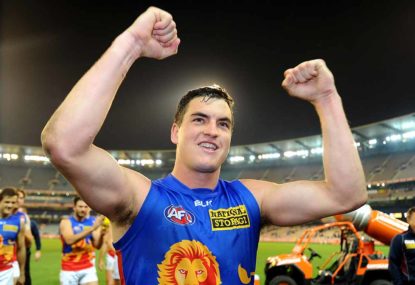'Took his eyes off the ball!' Young Crow's twin dropped sitters in last five minutes prove costly
It was a horror last quarter at the Adelaide Oval for Josh Rachele, who also missed a chance to win the game for the…

Tom Rockliff was discarded like sour chunky yoghurt. Dayne Beams – who looks, moves and plays like a modern day captain – was named skipper.
And it follows this pattern of team rejuvenation. Hawthorn marketed their hard-nosed style by anointing Luke Hodge as captain and tossing Sam Mitchell away to the periphery.
Sam Mitchell is a gun, but wasn’t the leader. He wasn’t angry/charismatic/ (insert other word) enough. He didn’t have that thing that captains have. Ultimately, it was a positive sum game. That happened, thousands of other things followed and Hawthorn won consecutive premierships.
Further to the point, Marc Murphy radiates a ‘let me focus on my game’ vibe and he leads the Carlton Football Club. Because Kade Simpson wasn’t – he didn’t have that something. Too skinny or not quite vocal enough. Maybe he lacked the critical acclaim, the right foot, the desire to captain or his face didn’t look as good on a button.
Perhaps there’s no causality, but the Murphy-over-Simpson captaincy decision coincided with a dark sad sometimes exciting but typically miserable period for the CFC. Murphy’s shoulders have collapsed, his back stiffened, his hamstrings tightened and his everything else coarsened by the weight of responsibility that shadows captaincy.
Because choosing the right captain is everything in modern day football.
The reasons for this totally escape me.
The game is so regimented. Each role is so precisely defined. Everyone digs their studs into their allotted territory and nobody encroaches unless they are told to do so because, well, they are told to do so.
Told to do so by a huge team of coaches and leadership groups and sports scientists and entertainment specialists. They prescribe where to run and what to do and when to eat and how to have sex so as to maximise aerobic capacity, stabilise breathing patterns and minimise injury.
It is all – at this point – basically autonomous. The training is so intensive that, when they are all buggered and flush, the players can fulfil their specialised role without active thought. They’re professional zombies. Some have personality and/or flair but that’s coached in and out of their game.
What room is there for the pointing-barking-huddling captain? What authority do they hold – over the vice captain and experienced peers – to be impulsive and display on-field leadership without external directive.
For smelling the dew, presaging the moment and changing the course of the game on the back of gut and feel.
The whole title seems like an unnecessary burden for the poor soul who is programmed and reprogrammed to expel clichés.
Having said all of that, I have no special animosity towards captains. Full disclosure, I wasn’t bowled as much as I would have liked during U12-18 cricket, but life is too short to hug that sticky grudge and call for the termination of anyone with leadership qualities.
And there seems to be some disparity between the same side led by a good/bad captain so, seeing as I’m gunning for the complimentary Roar merchandise, I ask the following questions.
1) What does a football captain actually do?
2) Is it all symbolic? Do they hold any official authority?
3) How much more is a captain’s goal worth (6+x=?)
4) What happens to the old captains? Tom Rockliff will presumably – at least out of habit – dish out advice. Is that advice now worth less?
5) I presume that tactics, positioning and anything that actually matters is set in motion by the people who sit in those transparent Gatorade-filled boxes. So how much narrative license do captains receive in their quarter break speeches?
*The same theory applies for all paragraphs but, particularly this one, it’s in accordance with my imagination (not anything grounded on reality.)